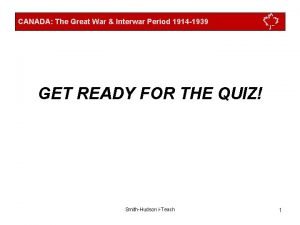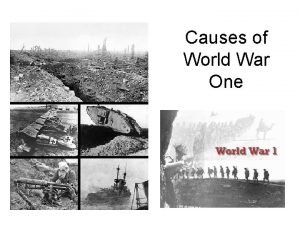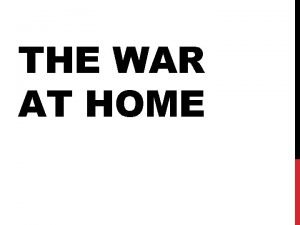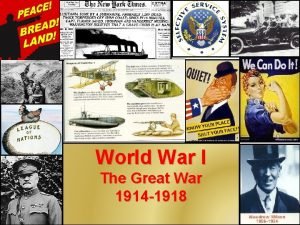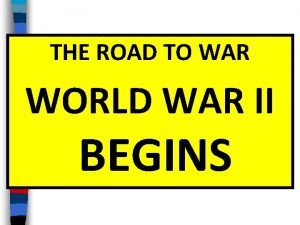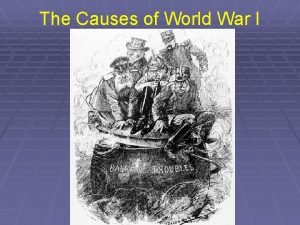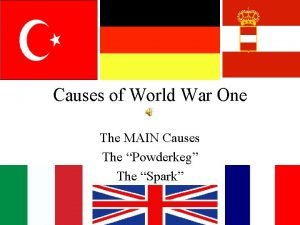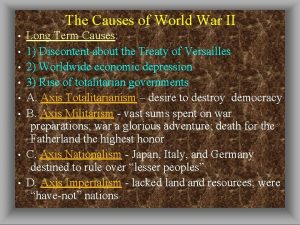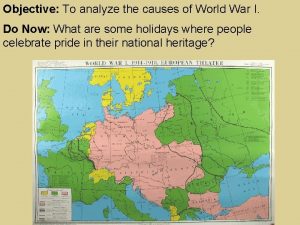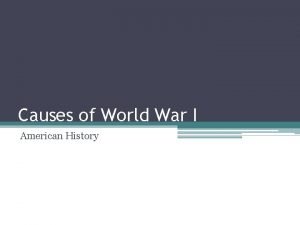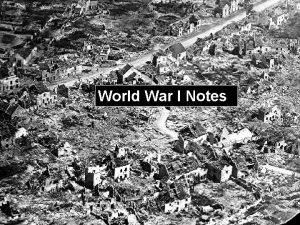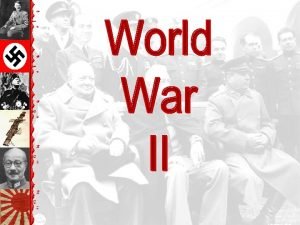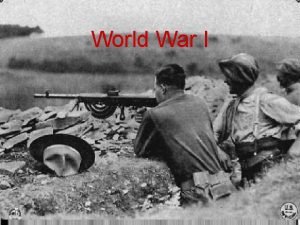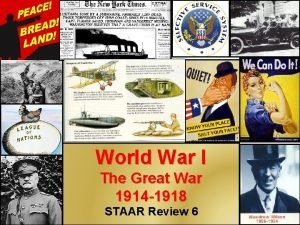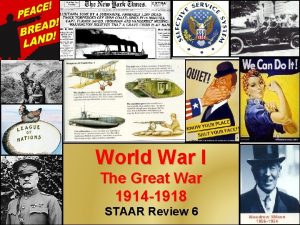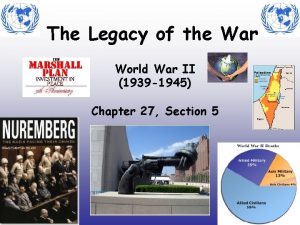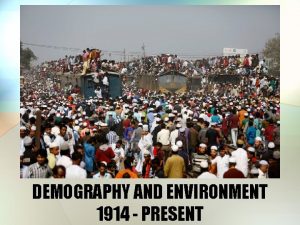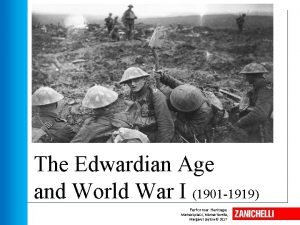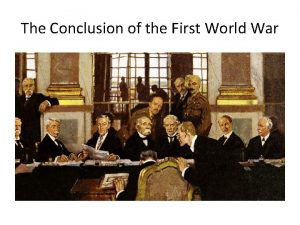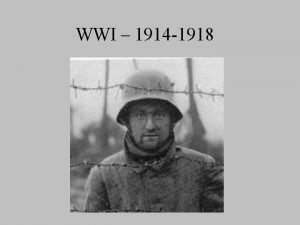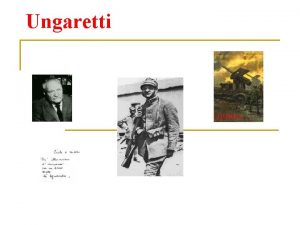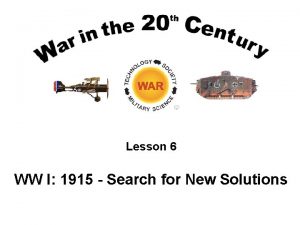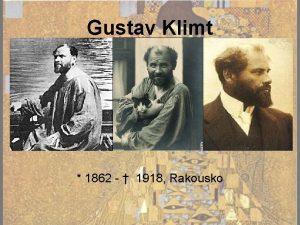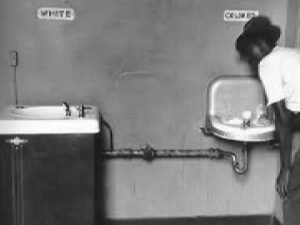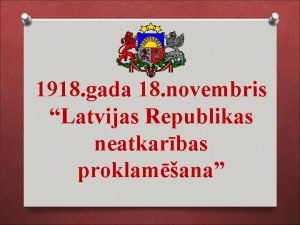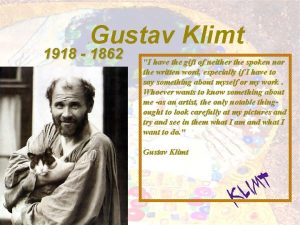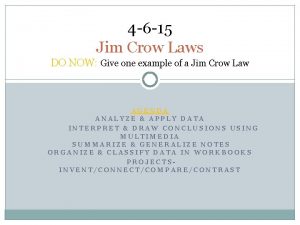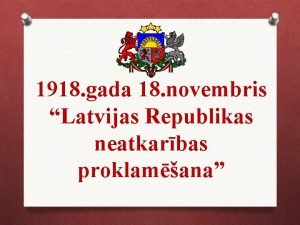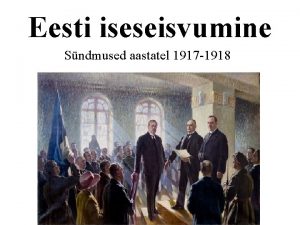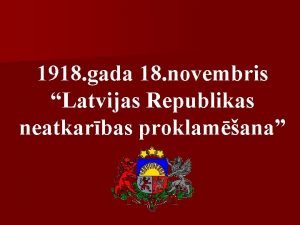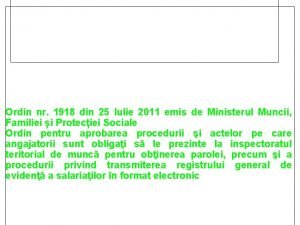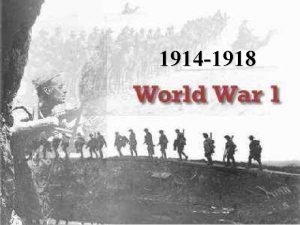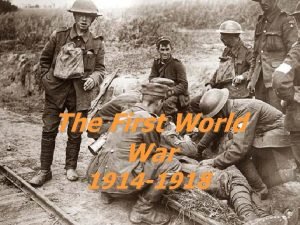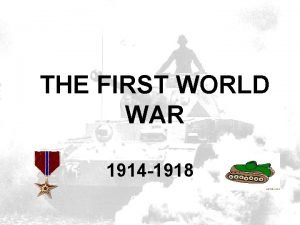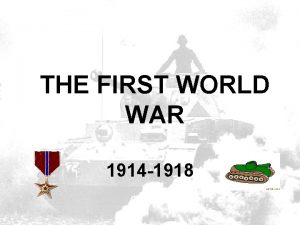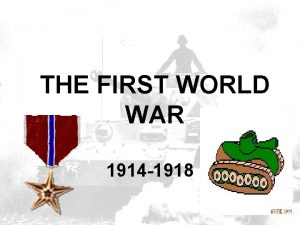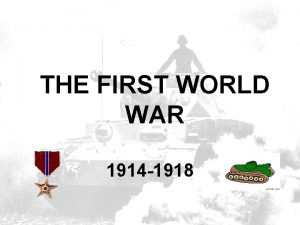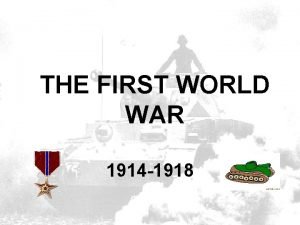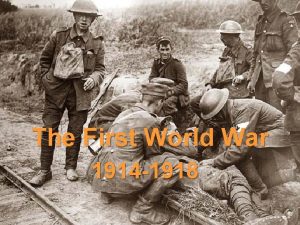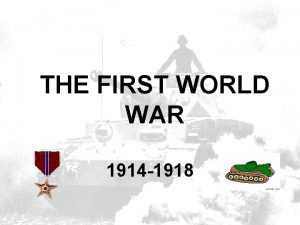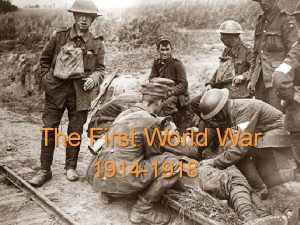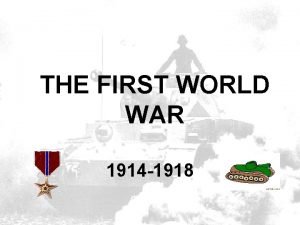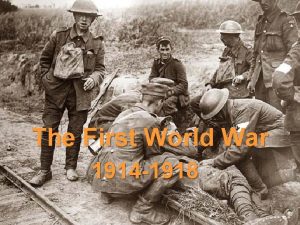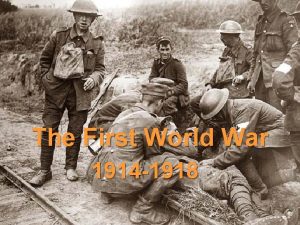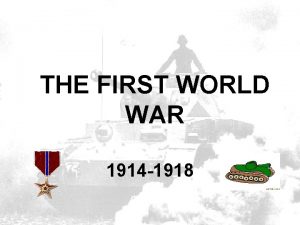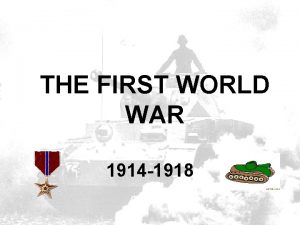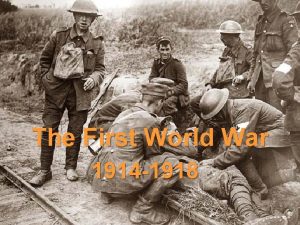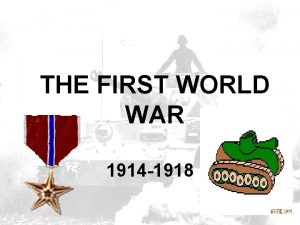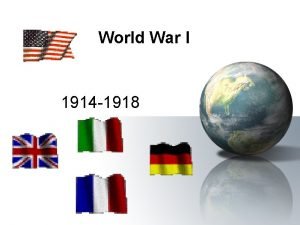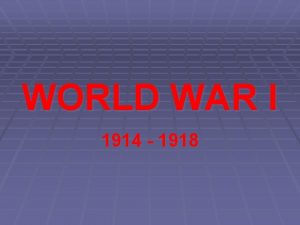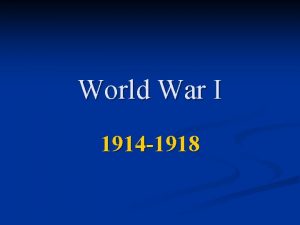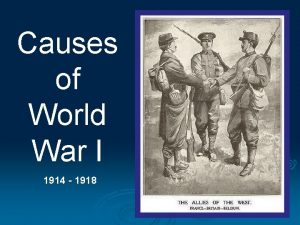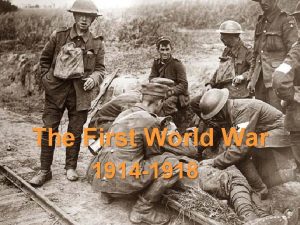THE FIRST WORLD WAR 1914 1918 CAUSES OF














































- Slides: 46

THE FIRST WORLD WAR 1914 -1918

CAUSES OF THE WAR Historians have traditionally cited four long-term causes of the First World War ØNATIONALISM – a devotion to the interests and culture of one’s nation ØIMPERIALISM – Economic and political control over weaker nations ØMILITARISM – The growth of nationalism and imperialism led to increased military spending ØALLIANCE SYSTEM – By 1907 Europe was divided into two armed camps

NATIONALISM § Often nationalism led to rivalries and conflicts between nations § Additionally, various ethnic groups resented domination by others and wanted independence § Russia and Austria. Hungary disagreed over the treatment of Serbs in central Europe Germany was allied with Austria-Hungary while Russia, France and Britain were partners


IMPERIALISM § For many centuries, European nations built empires § Colonies supplied European nations with raw materials and provided markets for manufactured goods § As Germany industrialized it competed directly with France and Britain § Major European countries also competed for land in Africa


MILITARISM Ø Empires had to be defended and European nations increased military spending enormously in the late 19 th and early 20 th century Ø By 1890 the strongest nation militarily in Europe was Germany Ø Germany had a strong army and built up a navy to rival England’s fleet Ø France, Italy, Japan and the United States quickly joined in the naval buildup

Battleships were being stockpiled by European nations, Japan and America in the late 19 th and early 20 th century

ALLIANCE SYSTEM Ø By 1907 there were two major defense alliances in Europe TRIPLE ENTENTE Ø The Triple Entente, later known as the Allies, consisted of France, Britain, and Russia FRANCE BRITAIN RUSSIA ØThe Triple Alliance, later known as the Central Powers, consisted of Germany, Austria-Hungary, and Italy (Soon joined by the Ottoman Empire


THE SPARK: AN ASSASSINATION Ø The Balkan region was considered “the powder keg of Europe” due to competing interests in the area Ø Russia wanted access to the Mediterranean Sea Ø Germany wanted a rail link to the Ottoman Empire Ø Austria-Hungary, which had taken control of Bosnia in 1878, accused Serbia of subverting its rule over Bosnia Ø Finally, in June of 1914, Archduke Franz Ferdinand, heir to the Austrian throne was gunned down by a Serbia radical igniting a diplomatic crisis The Archduke is assassinated in Sarajevo in June 1914

THE FIGHTING BEGINS Ø The Alliance system pulled one nation after another into the conflict – The Great War had begun Ø On August 3, 1914, Germany invaded Belgium, following a strategy known as the Schlieffen Plan Ø This plan called for a quick strike through Belgium to Paris, France ØNext, Germany would attack Russia Ø The plan was designed to prevent a two-front war for Germany The Schliefflen Plan

THE WAR BECOMES A STALEMATE § Unable to save Belgium, the Allies retreated to the Marne River in France where they halted the German advance in September of 1914 § Both sides dug in for a long siege § By the spring of 1915, two parallel systems of deep trenches crossed France from Belgium to Switzerland § There were 3 types of trenches; front line, support, and reserve § Between enemy trenches was “no man’s land” – an area pockmarked with shell craters and filled with barbed wire British soldiers standing in mud



German Soldiers The conditions in these trenches were horrific; aside from the fear of bombardment, soldiers also had to contend with the mud, flooding and disease associated with living in such a harsh environment.

FIRST BATTLE OF THE SOMME Ø During the First Battle of the Somme - which began July 1, 1916 and lasted until mid-November – the British suffered 60, 000 casualties the first day Ø Final casualties for the First Battle of the Somme totaled 1. 2 million, yet only 7 miles of ground was gained Gas attacks were common features of trench life and often caused blindness and lung disease Ø This bloody trench warfare, in which armies fought for mere yards of ground, lasted for three years

AMERICANS QUESTION NEUTRALITY Ø In 1914, most Americans saw no reason to join a struggle 3, 000 miles away – they wanted neutrality Ø Some simply did not want their sons to experience the horror of warfare Ø German-Americans supported Germany in World War I Ø However, many American felt close to the British because of a shared ancestry and language French propaganda poster portrayed the Germans as inhuman and impacted American attitudes toward the Germans Ø Most importantly, American economic interests were far stronger with the Allies

THE WAR HITS HOME Ø During the first two years of the war, America was providing (selling) the allied forces dynamite, cannon powder, submarines, copper wire and tubing and other war material Ø Both the Germans and British imposed naval blockades on each other German U-boat 1919 Ø The Germans used U-boats (submarines) to prevent shipments to the North Atlantic Ø Any ship found in the waters around Britain would be sunk

THE LUSITANIA DISASTER Ø United States involvement in World War I was hastened by the Lusitania disaster Ø The Lusitania was a British passenger liner that carried 1, 198 persons on a fateful trip on May 7, 1915 Ø A German U-boat sank the British passenger liner killing all aboard including 128 American tourists Ø The Germans claimed the ship was carrying Allied ammunition Ø Americans were outraged and public opinion turned against Germany and the Central Powers May 7, 1915

The N. Y. Times reports on the Lusitania

1916 ELECTION Ø The November 1916 election pitted incumbent Democrat Woodrow Wilson vs. Republican candidate Supreme Court justice Charles Evans Hughes Ø Wilson won a close election using the slogan, “He kept us out of war” Wilson Ø That slogan would prove ironic because within a few months the United States would be embroiled in World War I

AMERICA EDGES CLOSER TO WAR Several factors came together to bring the U. S. into the war; (Zimmerman note) Encoded message from Germany to Mexico Ø 1) Germany ignored Wilson’s plea for peace Ø 2) The Zimmerman Note, a telegram from the German foreign minister to the German Ambassador in Mexico, proposed an alliance Ø Germany promised Mexico a return of their “lost territory” in Texas, New Mexico, and Arizona Ø 3) Next came the sinking of four unarmed U. S. merchant ships by German subs

Zimmerman note intercepted by a British agent and decoded

AMERICA DECLARES WAR Ø A light drizzle fell on Washington on April 2, 1917, as senators, representatives, ambassadors, members of the Supreme Court, and other guests crowded into the Capital building to hear Wilson deliver his declaration of war Ø Wilson said, “The world must be safe for democracy” Ø Congress passed the resolution a few days later

THE WAR AT HOME Ø The entire U. S. economy was focused on the war effort Ø The shift from a consumer economy to war economy required a collaboration between business and government

WAR INDUSTRIES BOARD Ø The War Industries Board (WIB) encouraged companies to use mass-production techniques Ø Under the WIB, industrial production and wages increased 20% Poster encouraging production

VICTORY GARDENS Ø To conserve food, Wilson set up the Food Administration (FA) Ø The FA declared one day a week “meatless” another “sweetless” and two days “wheatless” Ø Homeowners planted “victory gardens” in their yards

SELLING THE WAR ØThe U. S. spent $35. 5 billion on the war effort Ø The government raised about 1/3 of that through an income tax and “sin” taxes Ø The rest was raised through war bonds sold to the public (Liberty Loans & Victory Loans)

ATTACK ON CIVIL LIBERTIES ØEspionage and Sedition Acts were passed by Congress Ø These acts were designed to prevent antiwar protests but went against the spirit of the First Amendment (Free speech) Any anti-American sentiments were targeted during wartime

SOCIAL CHANGE DURING THE WAR Ø The greatest effect of the First World War on the African American population was that it accelerated the Great Migration This African American family settled in Chicago Ø The Great Migration was the large scale population shift for hundreds of thousands of blacks from the south to Northern cities

WOMEN IN THE WAR Ø Many women were called upon to take on jobs previously held by men who were serving in the war Ø They became railroad workers, cooks, dockworkers, factory workers, and miners ØADD TO YOUR NOTES - Their service hastened the passage of the 19 th Amendment in 1920 giving women the right to vote Rosie the Riveter was the symbol of women’s war contributions

THE FLU EPIDEMIC Ø In the fall of 1918, the United States suffered a home-front crises when a flu epidemic affected 25% of the population ØThe epidemic killed as many as 500, 000 in the U. S. before it disappeared in 1919 Seattle, like many other places, became a masked city. All police wore them, as shown in this photo from "The Great Influenza" Ø Worldwide the epidemic killed 30 million people

AMERICAN POWER TIPS THE BALANCE Ø America was not ready for war – only 200, 000 men were in service when war was declared Ø Congress passed the Selective Service Act in May of 1917 Ø By the end of 1918, Extremely effective - 24 million had signed up and almost 3 million were called to duty

FRESH U. S. SOLDIERS JOIN FIGHT ØOne of the main contributions of the Americans was fresh and enthusiastic troops Ø American infantry were nicknamed “doughboys” because of their white belts

Role of women in WWI • 13, 000 volunteered for the armed forces in noncombat positions – They served as nurses, secretaries, and telephone operators

African Americans in WWI • Many were forced to work behind the lines jobs • US Troops were segregated • The 369 th Harlem Hellfighters fought with the French • Known for being the first African American Regiment during WWI • Many of these soldiers received honors from the French and U. S. government

AMERICAN TROOPS GO ON THE OFFENSIVE Ø Russia surrenders to the Germans in 1917, it allows the Central Powers to focus on the Western Front Ø The Americans arrived and immediately played a major role in pushing the Germans back Men of the 42 nd Division during the Second Marne. These men were killed by artillery fire just 5 minutes after this photo was taken Ø Americans helped the Allies win the Second Battle of the Marne

GERMANY COLLAPSES; COLLAPSES, THE GREAT WAR ENDS Ø On November 3, 1918, Germany’s partner, Austria. Hungary, surrendered to the Allies Ø That same day, German sailors mutinied against their government ØSo at the eleventh hour, on the eleventh day, of the eleventh month of 1918, Germany signed an armistice ending the Great War ends 11/11/18

WILSON FIGHTS FOR PEACE Ø Despite the hero’s welcome he received in Europe, Wilson’s plan for peace would be rejected by the Allies Ø Wilson’s plan was called the “Fourteen points” Ø Included in his “points” were: ü No secret treaties ü Freedom of the Seas ü More free trade ü Reduction of arms ü Less colonialism ü League of Nations to promote peace Wilson’s 14 points in his own short hand

ALLIES REJECT WILSON”S PLAN, SIGN TREATY Ø The Big Four leaders, Wilson (U. S. ), Clemenceau (France), Lloyd George (England), and Orlando (Italy), worked out the Treaty’s details Ø Wilson conceded on most of his 14 points in return for the establishment of the League of Nations Ø On June 28, 1919, the Big Four and the leaders of the defeated nations gathered in the Hall of Mirrors at Versailles and signed the Treaty of Versailles Hall of Mirrors

TREATY OF VERSAILLES The Treaty established nine new nations including; Ø Poland, Czechoslovakia, and Yugoslavia Ø The Treaty broke up the Austro-Hungarian Empire and the Ottoman Empire empires Ø The Treaty barred Germany from maintaining an army, required them to give Alsace. Lorraine back to France, and forced them to pay $33 billion in reparations to the Allies The Big Four met at Versailles


THE WEAKNESS OF THE TREATY The harsh treatment of Germany prevented the Treaty from creating a lasting peace in Europe Ø The Treaty humiliated the Germans by forcing them to admit sole responsibility for the war (War-Guilt Clause) Germans felt the Versailles Treaty was unfair Ø Furthermore, Germany would never be able to pay $33 billion in reparations

DEBATE OVER TREATY AT HOME Ø In the United States, the Treaty was hotly debated especially the League of Nations Ø Conservative senators, headed by Henry Cabot Lodge, were suspicious of the Leagues’ joint economic and military commitments Ø Many wanted the U. S. Congress to maintain the right to declare war Ø Ultimately, Congress rejected U. S. involvement in the very League the U. S. President had created The U. S. never did join the league

THE LEGACY OF WWI Ø At home, the war strengthened both the military and the power of the government Ø The propaganda campaign provoked powerful fears in society Ø For many countries the war created political instability and violence that lasted for years Ø Russia established the first Communist state during the war WWI 1914 -1918 22 million dead, more than half civilians. An additional 20 million wounded. Ø Americans called World War I, “The War to end all Wars” --- however unresolved issues would eventually drag the U. S. into an even deadlier conflict
 1914 1918
1914 1918 Causes of first world war
Causes of first world war Who reorganized the war industries board in 1918
Who reorganized the war industries board in 1918 3 cause of ww1
3 cause of ww1 Ww2 causes
Ww2 causes Long term causes of world war one
Long term causes of world war one Main wwi
Main wwi What are the causes of world war 2
What are the causes of world war 2 Causes of world war 1 mania
Causes of world war 1 mania Causes of world war 1 mania
Causes of world war 1 mania Mania militarism
Mania militarism Cause of world war 2
Cause of world war 2 Causes of world war 2
Causes of world war 2 Main ww1
Main ww1 4 causes for ww1
4 causes for ww1 Cause of world war 1
Cause of world war 1 Causes of wwii
Causes of wwii Pstuffy bunny
Pstuffy bunny World population 1914
World population 1914 Civil war first modern war
Civil war first modern war From the edwardian age to the first world war
From the edwardian age to the first world war First world war conclusion
First world war conclusion Proximate causation vs ultimate causation
Proximate causation vs ultimate causation Animal behavior biology
Animal behavior biology Map of europe in 1918
Map of europe in 1918 Rzeczpospolita trojga narodów mapa
Rzeczpospolita trojga narodów mapa Soldati ungaretti
Soldati ungaretti Shingelfrisyren
Shingelfrisyren Ft17
Ft17 1918-1862
1918-1862 Louisiana 1918 poll tax receipt
Louisiana 1918 poll tax receipt 1918 18 novembris
1918 18 novembris Red scare
Red scare Georgia history timeline 1877-1919
Georgia history timeline 1877-1919 Proiect educational 1 decembrie clasa 1
Proiect educational 1 decembrie clasa 1 1918-1862
1918-1862 1918-1862
1918-1862 1918-1862
1918-1862 Louisiana 1918 poll tax receipt
Louisiana 1918 poll tax receipt 1918 18 novembris
1918 18 novembris 11 listopada 1918 piosenka tekst
11 listopada 1918 piosenka tekst 1918-1862
1918-1862 Veebruarirevolutsioon
Veebruarirevolutsioon 1918 18 novembris
1918 18 novembris Gustv klimt
Gustv klimt Palestina 1918
Palestina 1918 Ommfps 1918/2011
Ommfps 1918/2011
